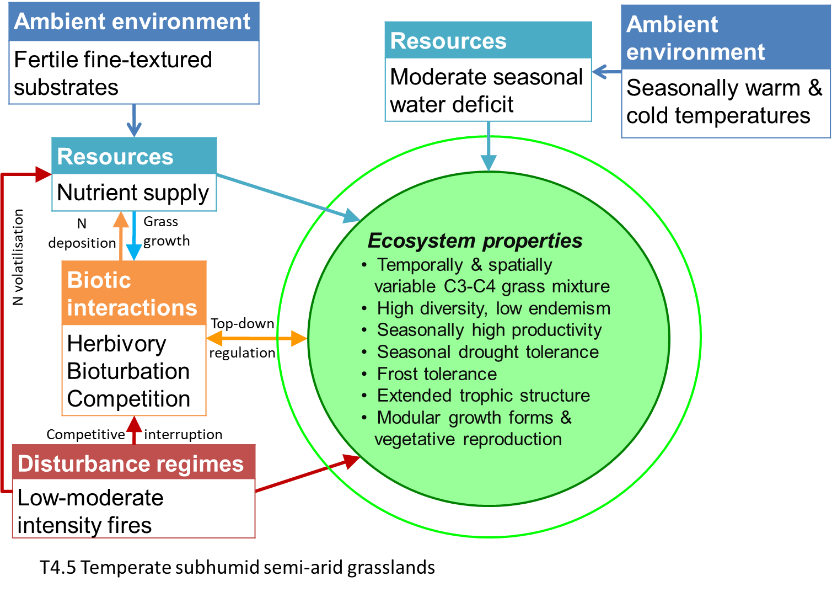Global ecosystem typology
Alternative site for the Global ecosystem typology with additional information for ecosystem profiles and indicative maps.
This site is maintained by jrfep
T4.5 Temperate subhumid grasslands
Biome: T4. Savannas and grasslands biome
Contributors:
(texts)
Temperate subhumid grasslands are simple in structure, composed of tussock grasses with scattered forbs, with few isolated trees and shrubs. Cold winters with occasional to frequent snow and frost limit the growing season, but hot dry summers create water stress. Nonetheless, fertile soils enable high productivity after rains, supporting a complex foodweb of invertebrates, ground-nesting birds, burrowing mammals, large herbivores, reptiles and predators. Large herbivores graze heavily, range widely, and are important in maintaining coexistence of plant species and nutrient cycling, as are periodic fires.
Key Features
Tussock grasslands with mixtures of C3 and C4 grasses and interstitial forbs, high productivity and complex trophic networks.
Overview of distribution
Temperate regions worldwide with summer water deficit, aseasonal precipitation that along with temperatures are lower than T4.4.
Profile versions
- v1.0 (2020-01-20): DA Keith; F Essl
- v2.0 (2020-05-31): DA Keith; F Essl; DJ Gibson
- v2.01 ():
- v2.1 (2022-04-06): DA Keith; F Essl; DJ Gibson Full profile available at official site
Main references
Selected references for this functional group:
Gibson GJ (2009) Grasses and grassland ecology Oxford University Press, Oxford
Diagrammatic assembly model

Maps
Maps are indicative of global distribution patterns are not intended to represent fine-scale patterns. The maps show areas of the world containing major (coloured red) or minor occurrences (coloured yellow) of each ecosystem functional group. See general notes on maps.
There are 2 alternative versions of the indicative map for this functional group, please compare description and sources below.
T4.5.IM.orig_v1.0
Datasets
- Resolve-Ecoregions-2017
Map references
Dinerstein E, Olson D, Joshi A, Vynne C, Burgess ND, Wikramanayake E, Hahn N, Palminteri S, Hedao P, Noss R, Hansen M, Locke H, Ellis EE, Jones B, Barber CV, Hayes R, Kormos C, Martin V, Crist E, Sechrest W, Price L, Baillie JEM, Weeden D, Suckling K, Davis C, Sizer N, Moore R, Thau D, Birch T, Potapov P, Turubanova S, Tyukavina A, de Souza N, Pintea L, Brito JC, Llewellyn Barnekow Lillesø JP, van Breugel P, Graudal L, Voge M, Al-Shammari KF, Saleem M (2017) An Ecoregion-Based Approach to Protecting Half the Terrestrial Realm, BioScience 67: 534–545. DOI:10.1093/biosci/bix014. Data-set available on-line
T4.5.web.orig_v1.0

Datasets
- Resolve-Ecoregions-2017
Map references
Dinerstein E, Olson D, Joshi A, Vynne C, Burgess ND, Wikramanayake E, Hahn N, Palminteri S, Hedao P, Noss R, Hansen M, Locke H, Ellis EE, Jones B, Barber CV, Hayes R, Kormos C, Martin V, Crist E, Sechrest W, Price L, Baillie JEM, Weeden D, Suckling K, Davis C, Sizer N, Moore R, Thau D, Birch T, Potapov P, Turubanova S, Tyukavina A, de Souza N, Pintea L, Brito JC, Llewellyn Barnekow Lillesø JP, van Breugel P, Graudal L, Voge M, Al-Shammari KF, Saleem M (2017) An Ecoregion-Based Approach to Protecting Half the Terrestrial Realm, BioScience 67: 534–545. DOI:10.1093/biosci/bix014. Data-set available on-line
Check: the Glossary / Profile structure / the public document